It’s encouraging to see the increased demand and awareness for canned tuna that doesn’t come with a high cost to our environment and marine life, especially given the enormous amount of canned tuna that is produced and consumed globally.
But I know it can be confusing to know which canned tuna to choose. So this post is my guide for how to choose sustainable canned tuna, along with some background information.

Summary: which canned tuna is best?
As a general rule for large brands sold at Australian grocery stores, choose skipjack tuna that is pole and line caught (ie no nets, best) or at least FAD-free* fishing methods (acceptable). Eat less yellowfin (ahi ahi) and albacore tuna. Do not buy bluefin and bigeye tuna or any tuna caught using FADs* with purse seine nets, gillnetting and longlining.
Read the canned tuna label to determine the tuna species and fishing method. The good news is most of the canned tuna at regular Australian grocery stores is caught using FAD-free methods these days.
IMPORTANT: This is not a blanket rule and some properly managed fisheries are sustainable. For example, Little Tuna in Queensland sells albacore tuna but it operates under the strict guidelines of the Australian Fisheries Management Authorities and they are dedicated advocates of sustainable Australian seafood. So where possible, I recommend doing your own research.
* FAD = Fish Aggregating Device = up to 7x unintended marine life casualties caught in nets = unacceptable!
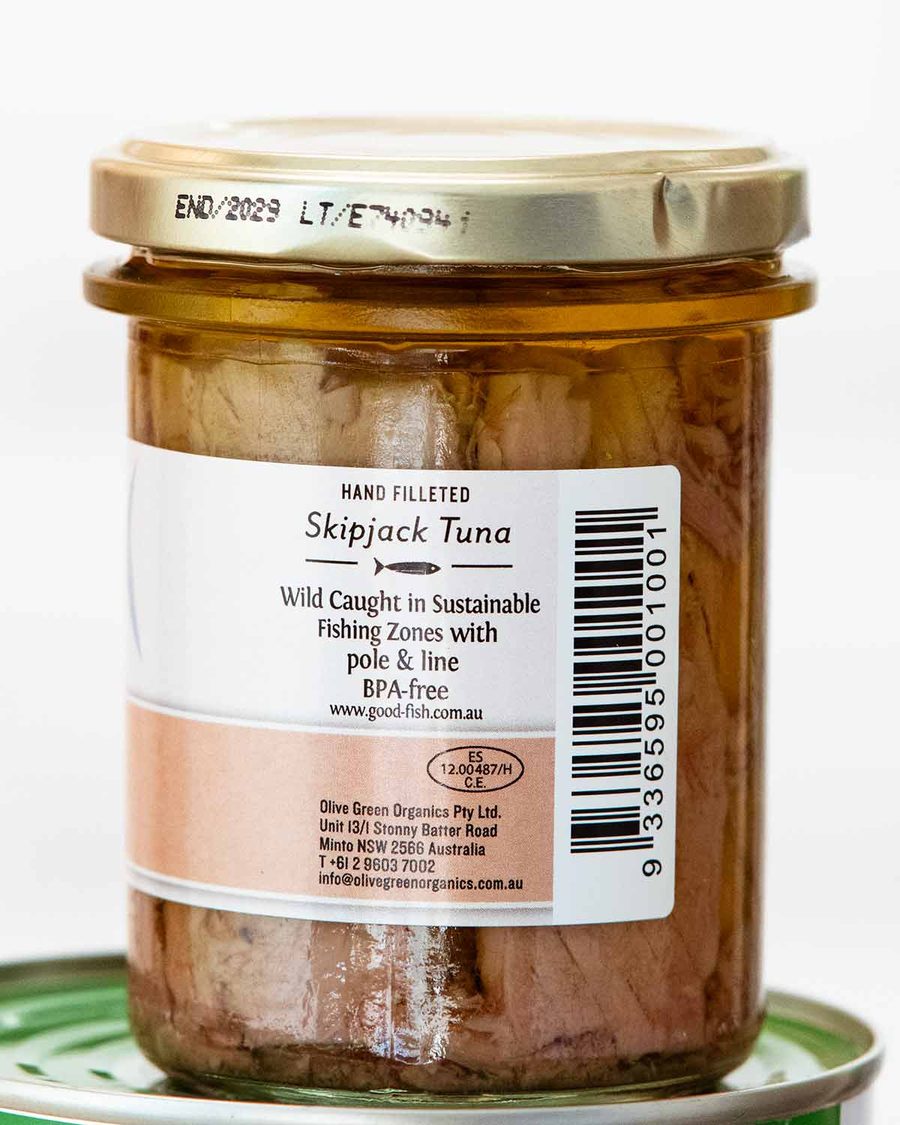
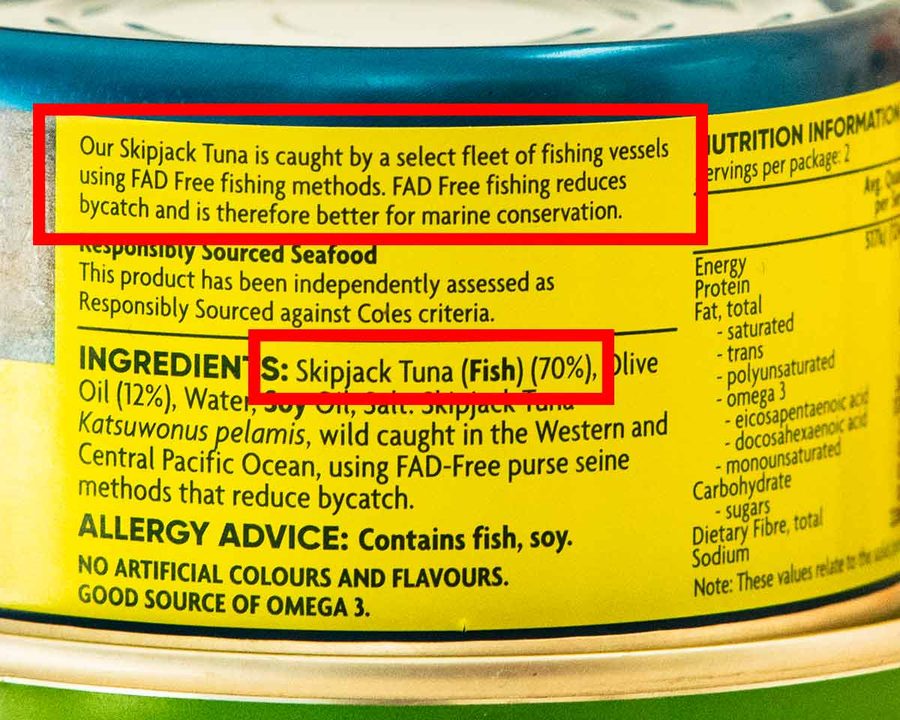
How to choose sustainable canned tuna
To determine if a can of tuna is sustainable or not, you need to know:
the tuna species – because some are critically endangered; and
the fishing method – destructive fishing methods damage the marine environment and up to 7x unintended marine life are caught and killed.
Read the label of the can to determine the type of tuna and how the tuna was caught. There is no regulated and standardised labelling system that reliably identifies sustainable canned tuna, so don’t rely on “responsibly sourced” stamps without checking the details!
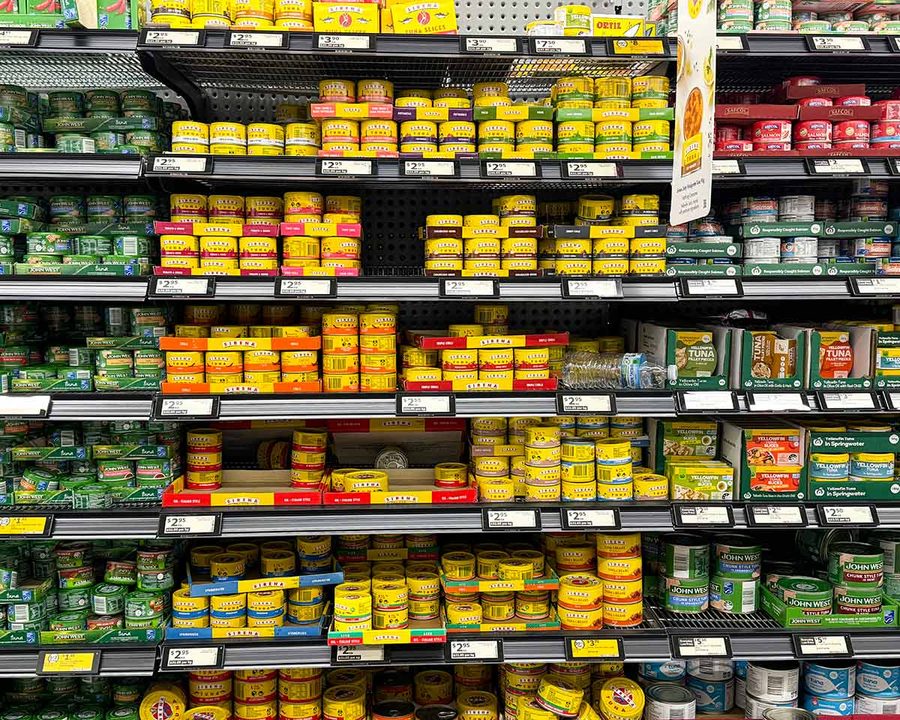
What to look for on the can
Here’s a summary of what to look for on canned tuna labels to choose responsibly. See sections below for further explanations.
1. Best available
Species: skipjack tuna – most responsible option.
Fishing method: Pole and line caught (no nets) – most responsible method of fishing because other marine life doesn’t get caught in the nets.
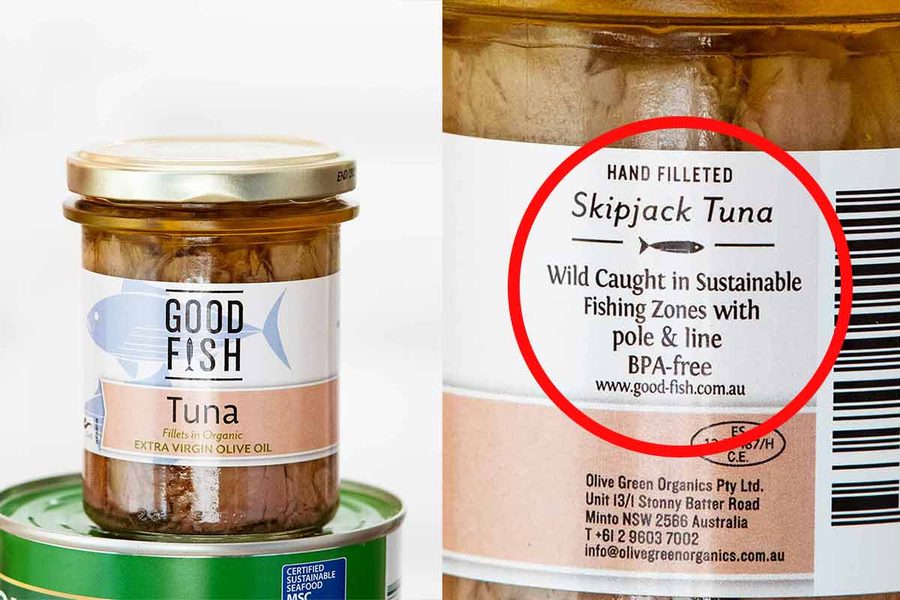
2. Acceptable
Fishing method: FAD-free purse seine, a method which reduces risk of other marine life getting caught in nets.

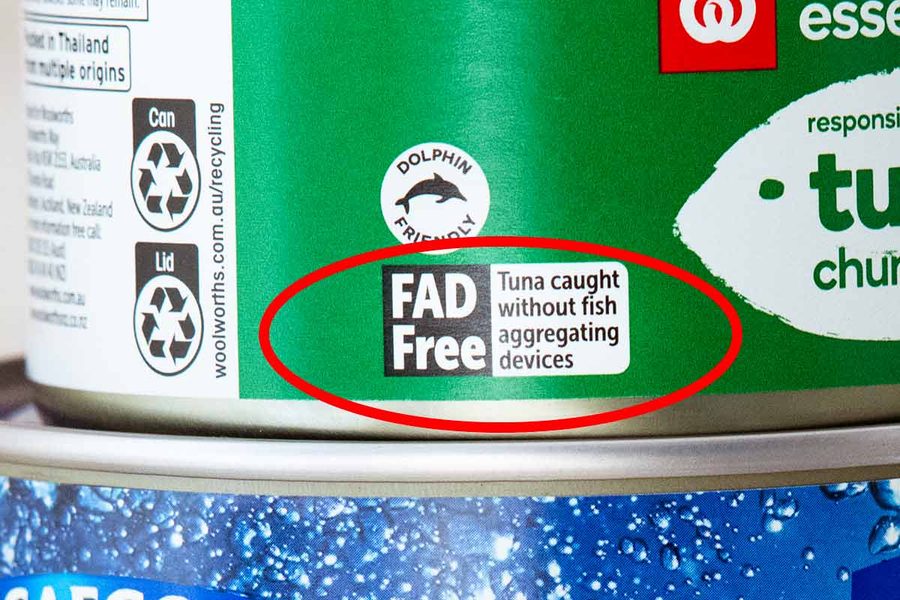
3. EAT LESS
Yellowfin and albacore – because these types of tuna are threatened. (But see caveat in the blue box at the top of the post!)
❌ DO NOT BUY
Species: Bluefin and bigeye tuna – critically endangered.
Fishing methods: FADs with purse seine nets, gillnetting and longlining. Up to 7x unintended targets can get caught and killed in the nets using these methods, as well as damaging the marine eco system. It is worth noting that all major Australian canned tuna brands are now FAD free.
⚠️ “Dolphin friendly” stamp is not always an indicator of true sustainable practices. More on the misuse of this label below.
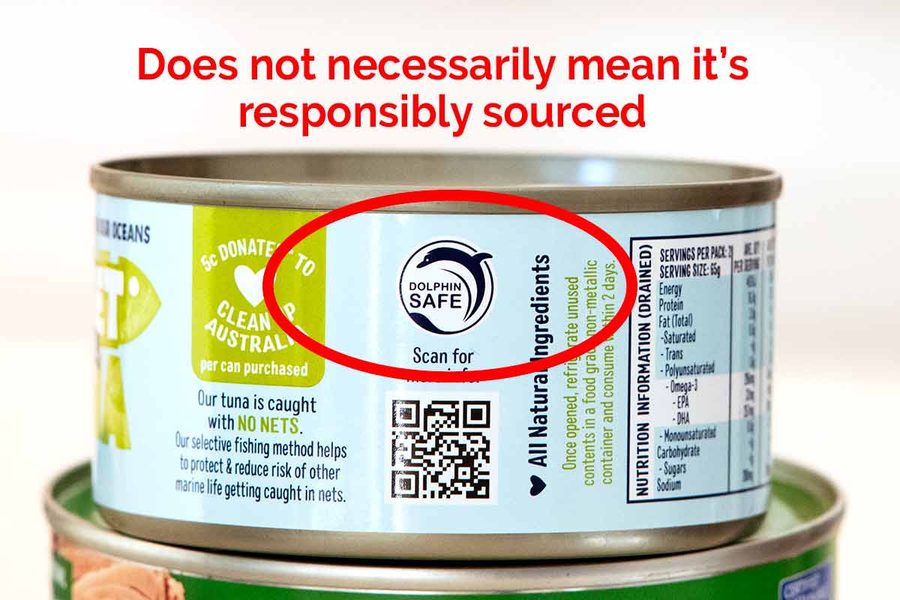
Recommended Australian Brands (mainstream)
BEST (pole and line caught skipjack tuna)
Good Fish
Fish4Ever
Safcol No Net Tuna (note that Safcol has other tuna products too)
ACCEPTABLE (FAD-free purse seine skipjack tuna)
John West
Greenseas
Safcol, Wild Tides
Woolworths & Essential brands
Coles & Smart Buy Brands
Aldi’s Portview
Note: Some of these brands also have yellowfin tuna products which falls under the eat less of category, so be sure to check the label!
EAT LESS
Sirena*
Yellowfin tuna product lines of above listed brands (most have them)
* Sirena is yellowfin tuna though it is pole and line caught so there is a trade-off here: threatened tuna species vs use of best fishing method.
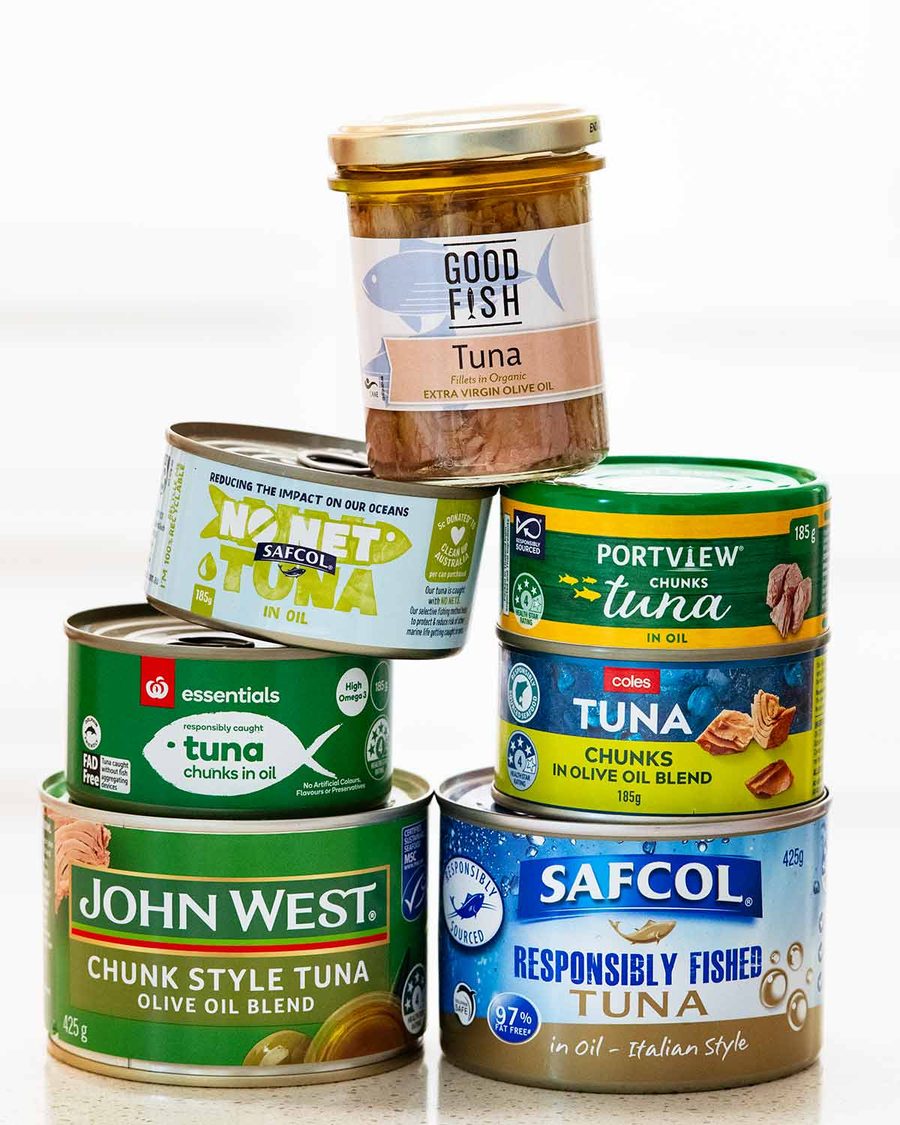
Why the fishing method matters
Because unethical fishing practices has a heavy cost on other marine life.
❌ The worst fishing method is tuna that is caught using Fish Aggregation Device (FADs) with purse seine nets, gillnetting and longlining. FADs are a device used to attract marine life (not just tuna). When enough have aggregated around the device, they are scooped up in giant nets – everything that is there, not just the tuna.
Fishing methods using FADs cause up to 7 times by-catch and killing of unintended target, including endangered species – fish, sharks, turtles.
⭐️ The best fishing method is pole-and-line caught tuna where each fish is caught individually using a fishing rod so there is little risk that other marine life is accidentally caught.
✔️The FAD-free purse seine is the most common tuna catching method for canned tuna currently sold at the large chain Australian grocery stores. This is considered a more responsible form of tuna fishing than using FADs because there is less risk of catching unintended targets in nets.

Why the tuna species matters
There are many types of tuna and so choosing a species of tuna that is being fished at a rate that is not threatening the population matters.
❌ Tuna types to avoid
bluefin tuna – critically endangered
bigeye tuna – overfished, low population
These are premium types of tuna typically only found at high end sashimi and sushi restaurants, not often seen here in Australia.
Eat less
Yellowfin tuna (also known as Ahi Ahi tuna in the US) and albacore tuna (aka white tuna) – these types of tuna are threatened
Yellowfin is the type of tuna that is often served in raw form such as sashimi, sushi, ceviche and crudos. It is a favourite of fine dining establishments for the colour, texture and flavour.
Less-concerned
Skipjack tuna – This is the type of tuna that is most commonly used for canned tuna sold at mainstream Australian grocery stores.
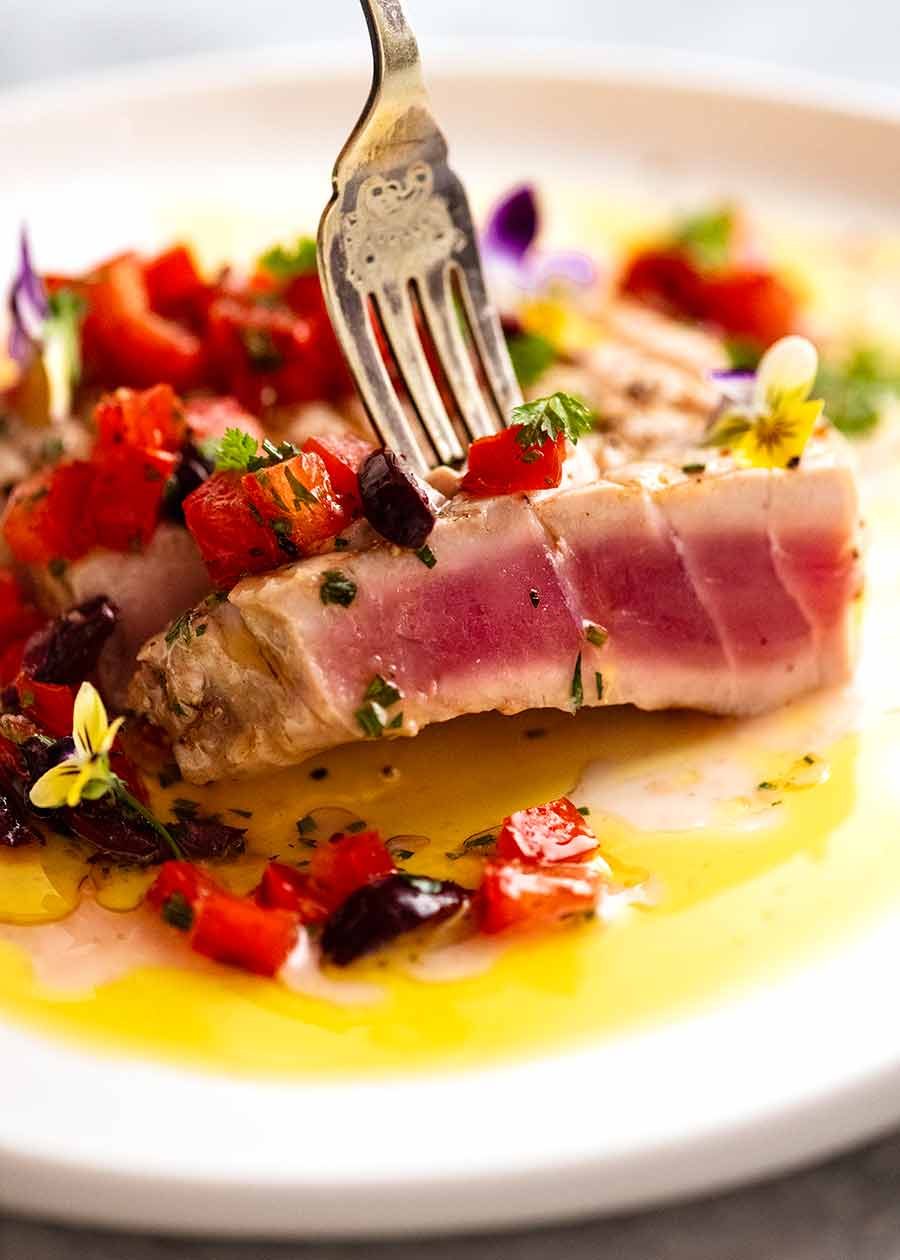
Balancing budget with sustainable choices
I know that budget comes into consideration here when making sustainable food choices, because the more sustainable canned tuna is typically more expensive.
Having said that though, Safcol No Net Tuna, which is a gold-star responsible product, is sold at Woolworths in Australia and is around the same price as other major brands. So I’m confused, why I found it tucked away on the bottom shelf and why it isn’t available at Coles and other grocery stores – further investigation pending!
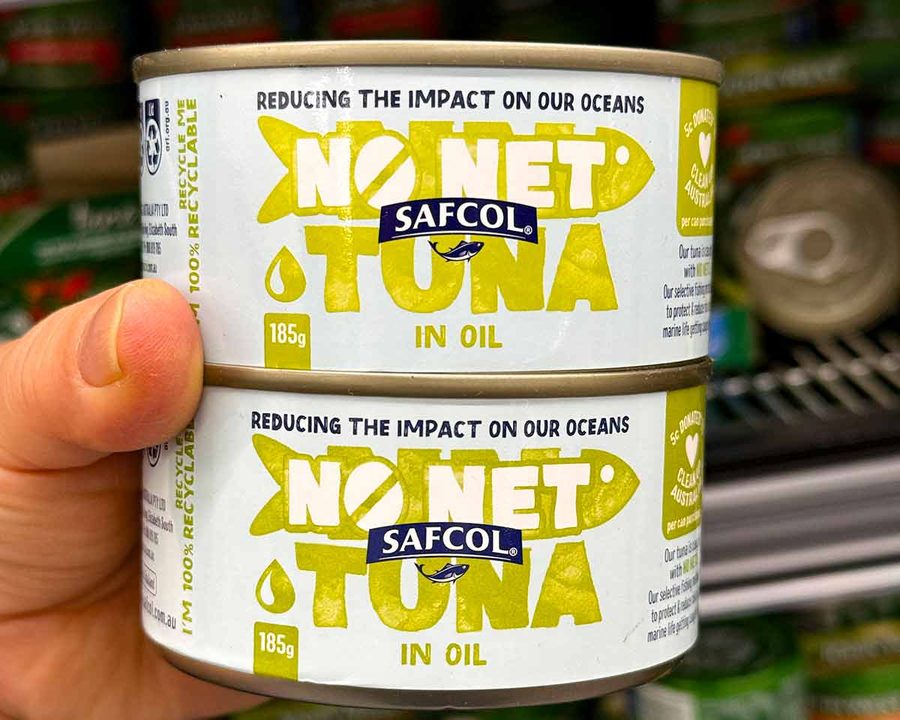
But with information comes the ability to make informed decisions so we can do the best we can to play our part to make a difference.
So that’s what I’m doing with this post.
And the good news is that most of the canned tuna at regular grocery stores here in Australia is considered relatively responsible these days. But make sure to read the label! And don’t instinctively reach for canned tuna with a “dolphin friendly” stamp on it which can be misleading. Here’s why.
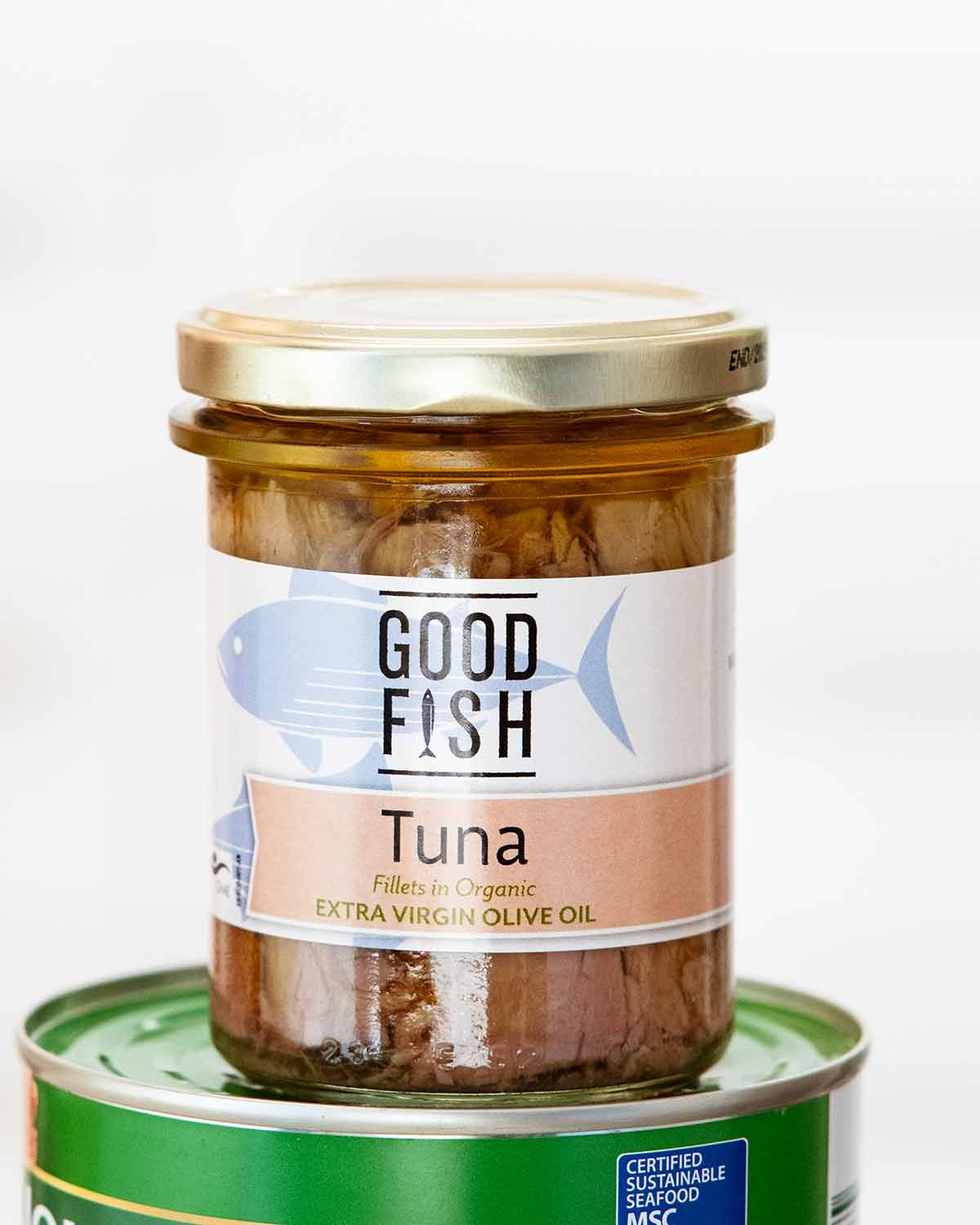
Misleading “dolphin friendly” stamp
The “Dolphin friendly” labelling that you see on virtually all cans of tuna is not a true indicator of sustainable practices here in Australia. This is because the use of this stamp is not regulated.
For example, most of the canned tuna we consume in Australia comes from the Pacific in an area where dolphins are not common. So catching tuna in a “dolphin friendly” manner is not relevant!
The “dolphin friendly” label is more relevant to the US where dolphins do live with tuna and are victims of unethical tuna fishing practices.
Note: Not all brands mis-use the dolphin safe label, like Safcol No Net Tuna product line which is pictured below. But knowing that some do means it’s a label we can’t always rely on.

In closing: a note on personal principles
I would be remiss in not tell you that I eat and appreciate the qualities of the premium tuna species listed above as avoid or eat less of. I have even shared recipes using them.
But they are a special treat rather than an everyday ingredient, consumed sparingly in raw form, and certainly not used anywhere near the scale of mass produced canned tuna.
Here in Australia, yellowfin tuna served in raw form (think – tartare, ceviche, sashimi) is common at fine dining restaurants. Just try to choose fish sourced using sustainable practices – ask your server! Though these days, you’ll find that sustainability is at the forefront of restaurants run by well respected chefs in our country.
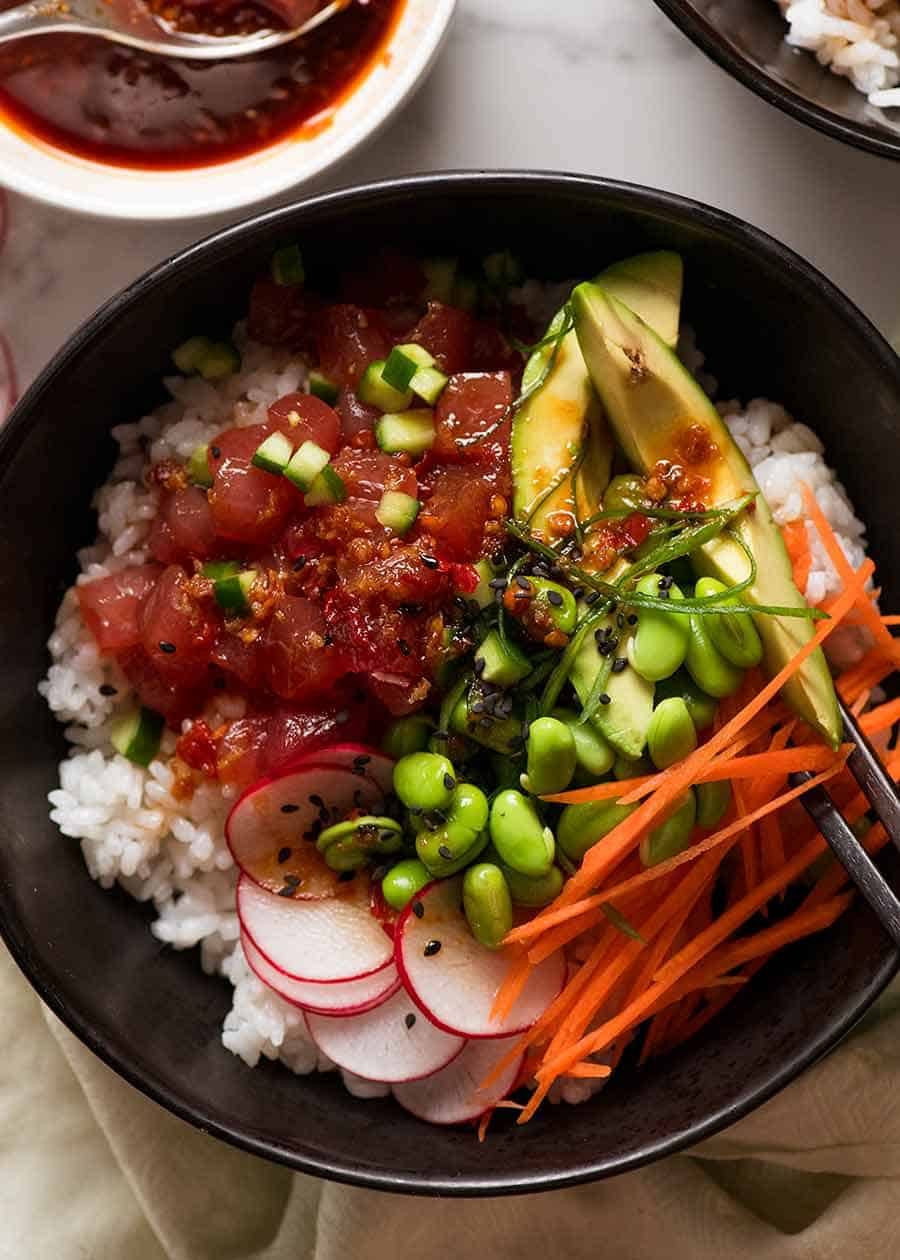
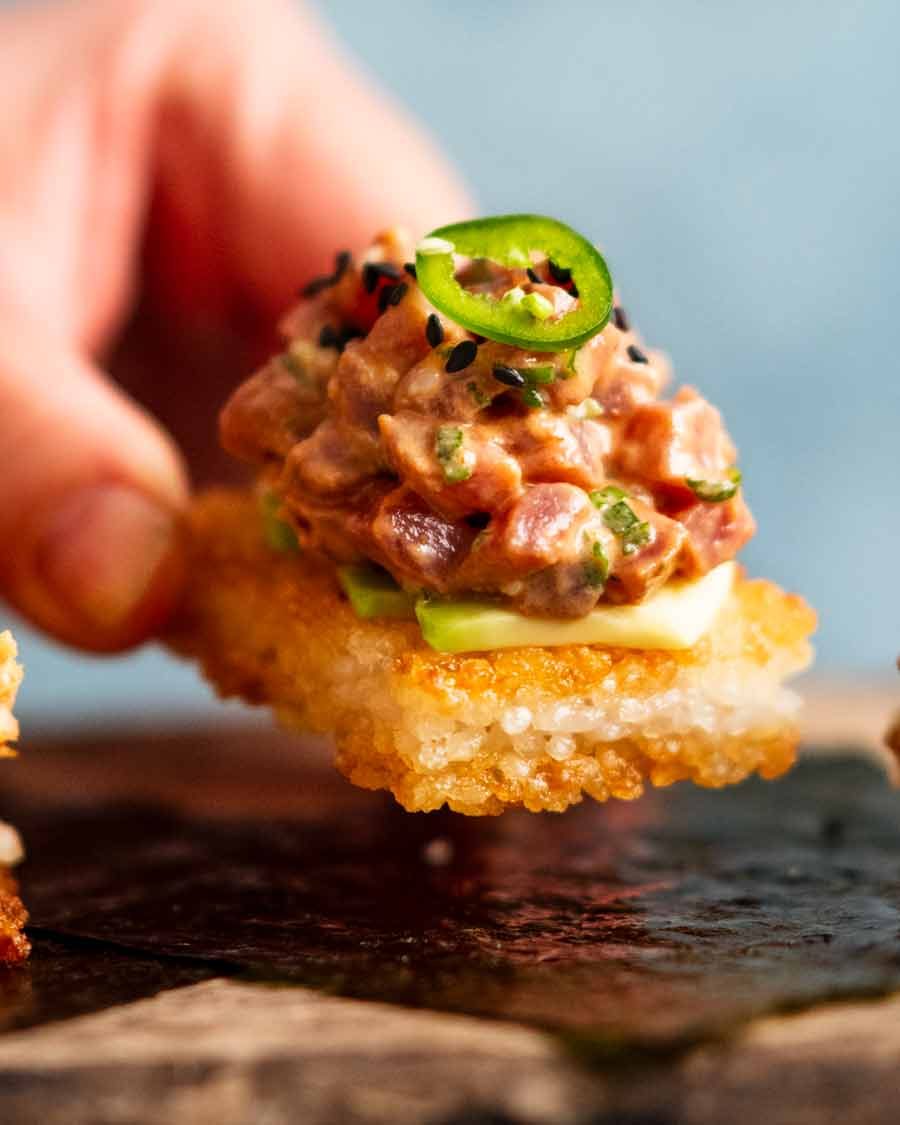
Why all of a sudden a post on sustainable eating?
And if you’re a regular reader wondering why is Nagi all of a sudden doing a post on sustainable eating? The answer is this: cooking, food and sourcing of ingredients is an ongoing journey of education. I learn something new every single day, and this includes learning more about sustainability of food.
As a general recipe website, the focus on what I do is around providing recipes. But where possible, or where a topic is of personal significance to me, I will at times share what I have learned and my personal opinion on things – whether it be my favourite brand of curry pastes, that I detest store bought fish stock, choosing between grass and grain fed beef or what I know about choosing responsible canned tuna. 🙂
I hope you’ve found this post useful! – Nagi x
Information sources
Good Fish – Australia’s sustainable seafood guide
Green Peace – About sustainable tuna
Green peace – How to find the most sustainable canned tuna
The Spruce Eats – Sustainable fish choices
My favourite canned tuna recipes
Life of Dozer
Swing the camera a fraction to the right and this is what fills the lens:
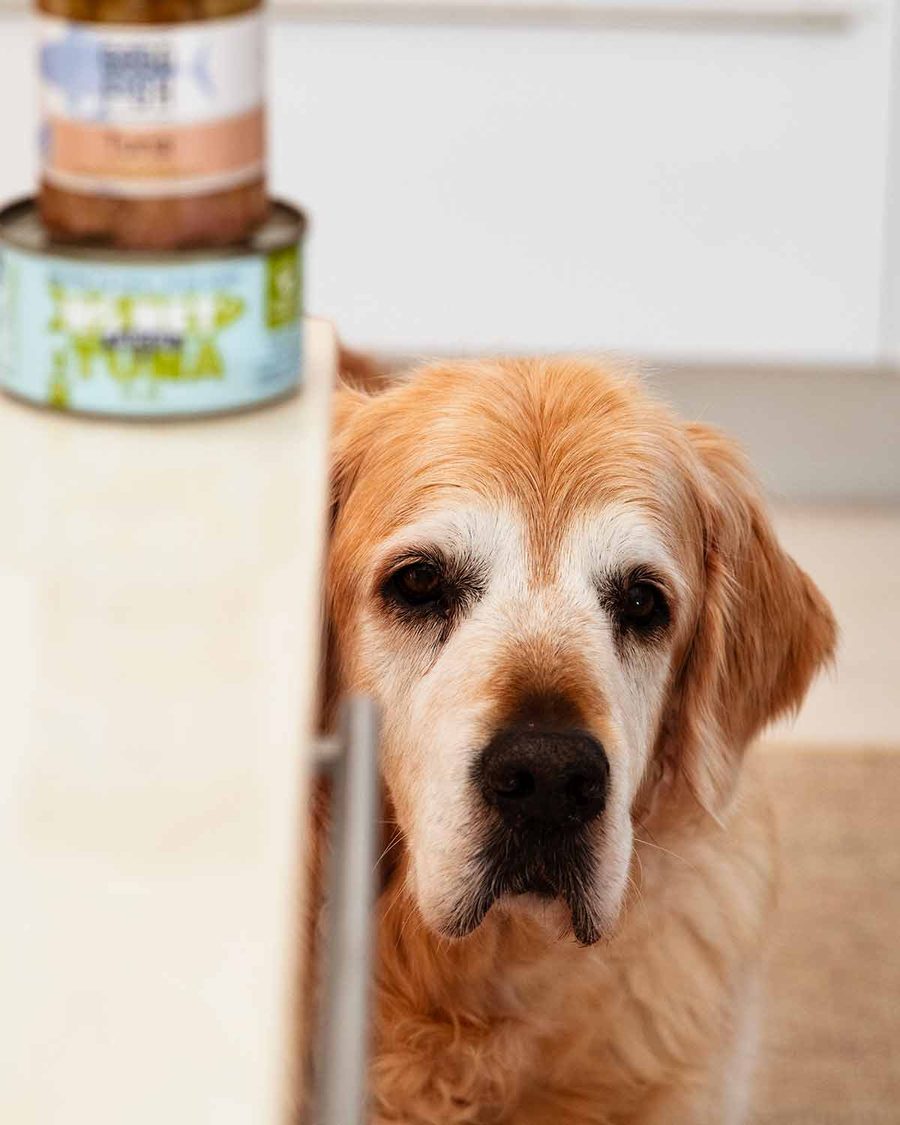
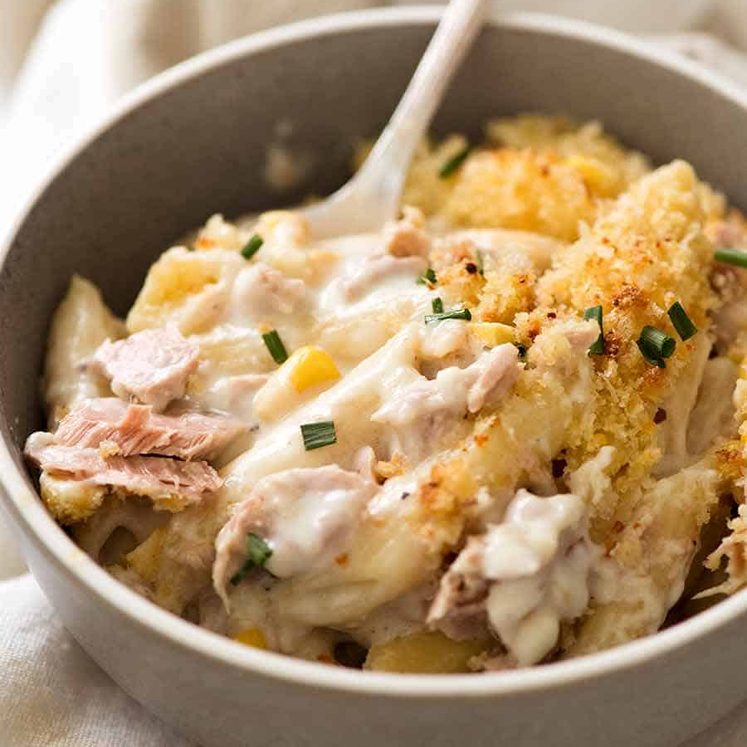
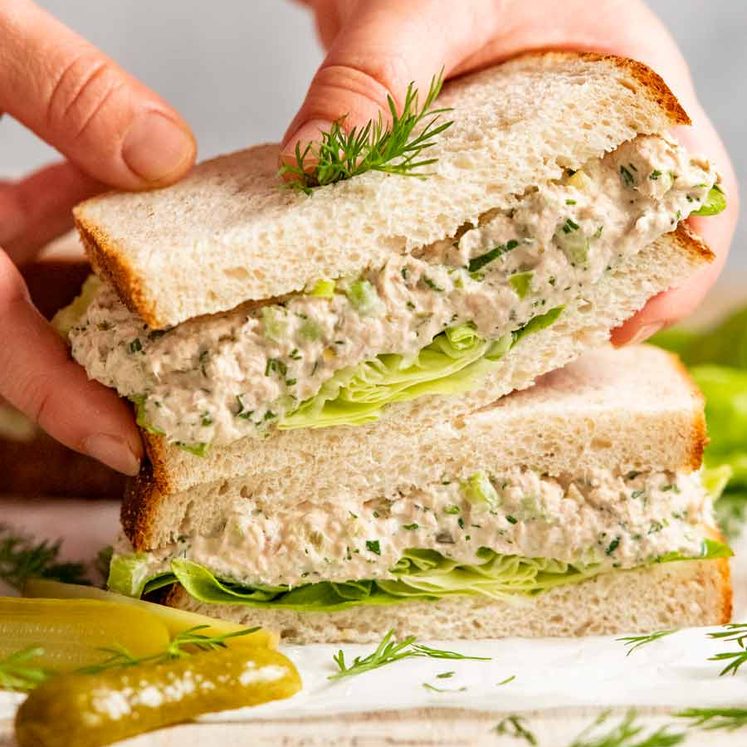
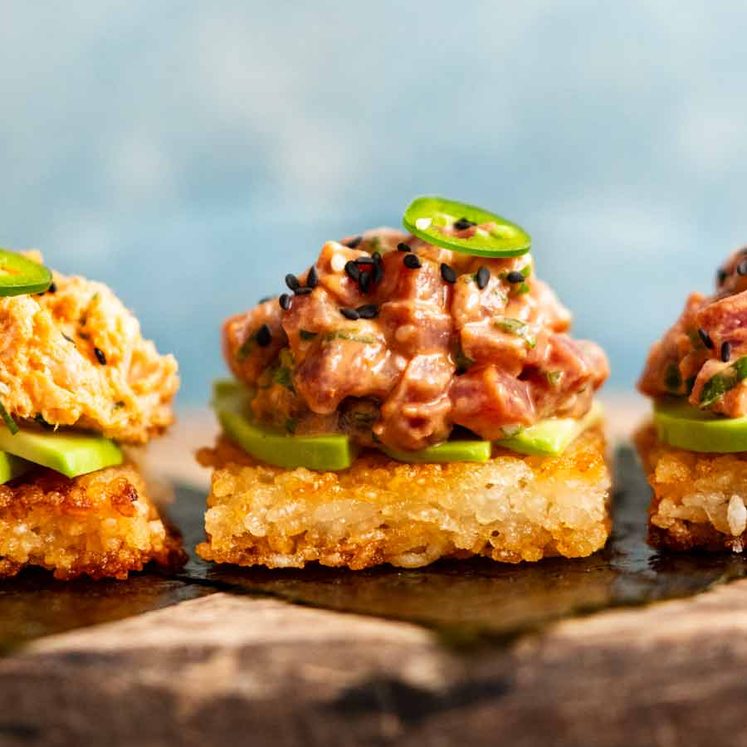
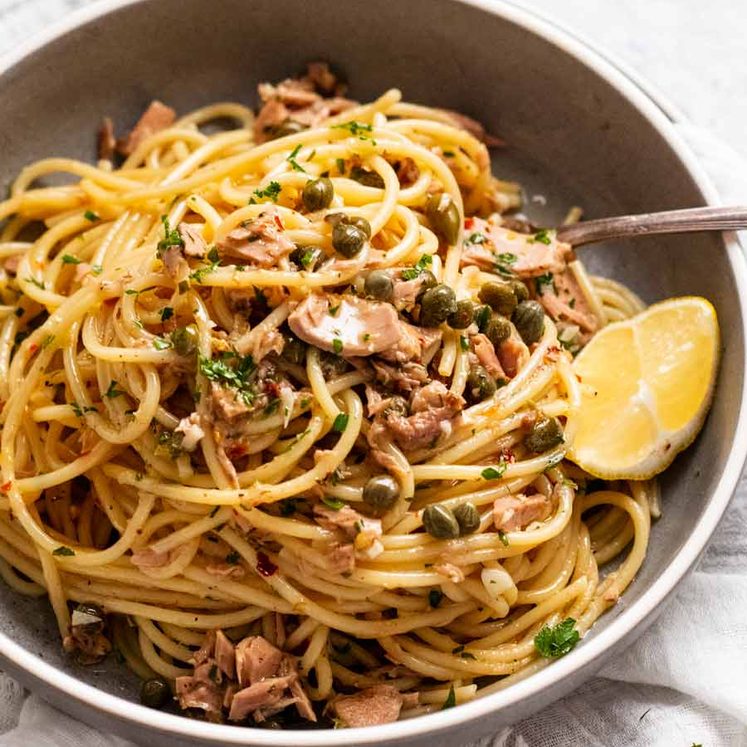
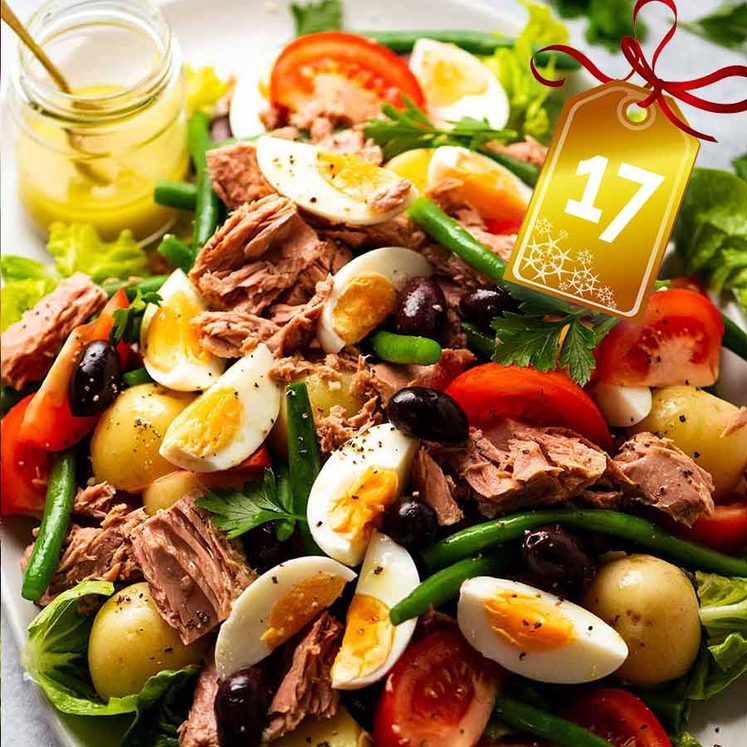
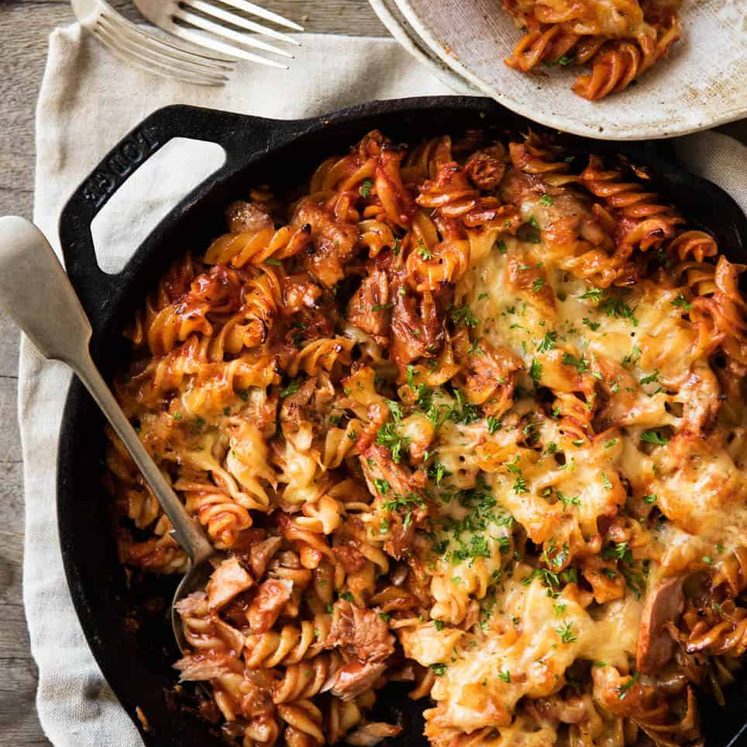
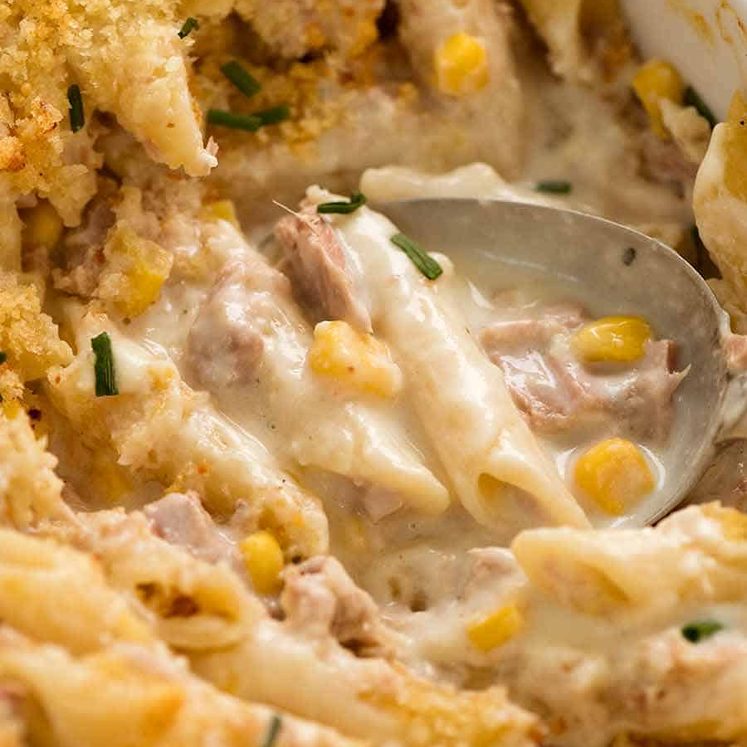
Great article Nagi. We watched a doco a while back, about the canned tuna industry, I decided at the time, I would eat a lot less tuna. As you mentioned, there really are no proper regulations in this industry world wide
Thanks Nagi – so good to know and I will definately change what I buy
Thank you for this great article. I’d also like to draw attention to human slavery in fish. It’s unfortunately common. Just Kai has a great guide to avoiding slave-caught and processed fish on their website (I’m not them, but I’m a big supporter and have learned much!)
https://justkai.org.nz/guides/
Wow this is a great read thank you I have now become more aware on what to buy I didn’t know alot of this information
Thanks Nagi, it’s good for us all to be aware. We only have this planet and it’s creatures to sustain us, we need to do whatever we can to help preserve it for future generations. xx
Interesting and a good read! its great to have these in mind when shopping – its the seed oils thats also an issue for many of us with autoimmune issues…
After watching the documentaries on net fishing in our world I was so horrified I have stopped buying tuna. I really appreciate your article and that you have shared this information as I have missed eating/cooking tuna recipes. So next shop I will be looking for your recommendations. Thank you Nagi!
Thank you so much for summarising this important and interesting information.
Thank you for using your broad reach to share this information and make a difference for our environment. It’s why we love you Nagi!
Thank you so much for this information and all the research you have done. The more research I did the more confused I became.
Thanks Navi.
The last time I went to buy tuna I was so overwhelmed by the number of choices that I decided I wouldn’t buy it anymore. Now I know what to look for.
Thanks for the info, I didn’t know to look for the fishing method. I haven’t bought tuna for years because of the mercury content, besides concerns about Fukushima releases into the Pacific.
Thank you for all this information!
Seafood Watch, from Monterey Bay Aquarium in California, has extensive guides on sustainable seafood. https://www.seafoodwatch.org/
Great information to have. Thanks so much Nagi. I will be changing what I purchase.
Good on you Nagi for taking the responsibility to post this! It is really encouraging to see.
Thank you for this, Nagi. Here in the US I too am concerned about tuna, which I love. It is quite time consuming to find the right tuna. Sometimes I buy online where it is easier to buy sustainably. And thank you for the pic of that sweet Dozer ❤️
Thanks for the Tuna tune up, it was nicely done….. I noticed that all your samples were tuna in oil…here in Ontario Canada the majority is in water.. comment?
How do you tune a fish?
Count the scales!
Fantastic post and thank you for doing all the research for us! I love all your recipes (your choc chip chocolate muffins are to die for!) and especially that nutritional info is included at the end. Very helpful for those of us watching carbs, etc. please give Dozer a hug from me🥰
Thankyou. Having you help cooks make informed sustainable choices is a bonus.